When designing efficient storage systems for light-duty applications, choosing the right light-duty shelving type is crucial. The right choice can improve workflow, reduce picking time, and minimize maintenance costs. In this article, we compare
bulk rack, tab rack, and rivet shelving to help you decide which system fits your business best.
What Is Light-Duty Shelving?
Light-duty shelving is intended for manual handling of smaller or medium-weight items rather than full pallets. It’s commonly used in parts rooms, spare-parts inventory, kit zones, or overflow storage. Because these systems often integrate with workflows, ergonomics, and picking operations, selecting the right type is more than just capacity—it’s about usability, flexibility, and lifecycle cost.

Bulk Rack Shelving
Bulk rack shelving is designed to hold large, bulky items in open span configurations. It is sometimes called “industrial shelving” and supports heavier loads than consumer-style shelves. Bulk racks allow clear access from front or rear for hand loading.
Bulk racks are designed to support moderate loads, making them ideal for medium-sized warehouses and operations that need efficient, stable, and secure storage solutions. When properly installed and maintained, they also help ensure compliance with
warehouse safety standards established by OSHA, reducing risks associated with overloading and improper handling.
Pros
- High load per shelf, good for bulky, heavy items
- Flexible span widths and depths
- Clear access to inventory, no hindering crossbars
Cons
- Larger footprint
- May not be as space optimized for smaller SKUs
- Higher initial cost for heavy-duty components
Use case: Useful when you have items too large or heavy for standard shelf systems but that don’t justify full pallet racks.
Tab Rack Shelving
Tab rack shelving is a variation of boltless shelving that uses tab connectors (tabs that lock into slots) to hold solid metal shelves in place. It offers a good middle ground between heavy duty and lightweight systems. RackUSA offers Boltless Tab Rack Shelving in its catalog.
Rack USA
Pros
- Tool-free assembly and reconfiguration
- Good load capacity for parts, bins, boxes
- Lower cost than bulk racks for moderate duty
Cons
- Not ideal for extremely heavy or awkward loads
- Limited span compared to bulk rack
Tab rack is ideal when you want solid shelf decks, modular adjustability, and easier access for midsize items.
Rivet Shelving (Boltless Rivet)
Rivet shelving (also called boltless shelving or rivet racks) is popular for light to medium load applications where ease of assembly and flexibility are important.
Pros
- Very easy, tool-free assembly
- Highly modifiable (add or rearrange levels)
- Good for small parts, bins, stockrooms
Cons
- Not designed for extremely heavy or bulky inventory
- Less span and load strength compared to bulk rack
Rivet shelving system is ideal for SKU-dense operations, small parts storage, or zones where flexibility is key.

Comparison Summary
| Feature |
Bulk Rack |
Tab Rack |
Rivet Shelving |
| Best for |
Heavy, bulky items |
Medium weight parts / bins |
Light to medium loads, small parts |
| Assembly complexity |
Moderate |
Low |
Very low |
| Flexibility / reconfiguration |
Moderate |
High |
Very high |
| Span / width potential |
Highest |
Moderate |
Limited |
| Cost per shelf |
Higher |
Moderate |
Lower |
In many facilities, the optimal approach is mixing these systems: use bulk rack for heavy or irregular items, tab rack for moderate SKUs, and rivet shelving for high-density parts or kits.
Integrating Into Your Workflow
Selecting is only half the battle. To maximize value:
Analyze SKU sizes, weights, and turnover
- Plan shelf depths and widths to minimize wasted space
- Consider future growth or automation
- Incorporate safety (anchoring, edges, signage)
- Train staff in best practices
When choosing between bulk rack, tab rack, and rivet shelving, it’s essential to consider your facility’s load requirements, product types, and access frequency. Consulting reliable industry resources such as the
Material Handling Institute’s storage guidelines can help you identify the most efficient and durable system for your specific operational needs.
👉
Contact RackUSA today for a free consultation and let us help you choose or custom-engineer the perfect shelving system for your business.

FAQs
Can I mix bulk rack, tab rack, and rivet shelving in one facility?
Absolutely. Many operations optimize performance by using the right shelving system for each zone or SKU set.
Which system is easiest to reconfigure?
Tab racks are the most flexible, followed by rivet shelving, then bulk racks.
Are these systems compatible with automation later?
Yes — if you plan early, you can provision clearances and structural support for conveyors, pick carts, or automation.
How do I choose based on weight per shelf?
Always check manufacturer rated loads; bulk rack typically supports higher loads per shelf than the others.
Is rivet shelving strong enough for industrial use?
Yes — for light to medium parts and bins. It may not be suitable for heavy or irregular items.



